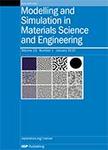版权所有:内蒙古大学图书馆 技术提供:维普资讯• 智图
内蒙古自治区呼和浩特市赛罕区大学西街235号 邮编: 010021

作者机构:Sandia Natl Labs Engn Sci Ctr POB 5800 Albuquerque NM 87185 USA
出 版 物:《MODELLING AND SIMULATION IN MATERIALS SCIENCE AND ENGINEERING》 (材料科学与工程中的模型建立与模拟)
年 卷 期:2019年第27卷第2期
页 面:025003-025003页
核心收录:
学科分类:08[工学] 0805[工学-材料科学与工程(可授工学、理学学位)] 080502[工学-材料学] 0702[理学-物理学]
基 金:US Department of Energy's National Nuclear Security Administration [DE-NA-0003525]
主 题:additive manufacturing texture mechanical properties model form error microstructure variability a posteriori error estimation
摘 要:The repetitive rapid solidification that occurs in metal additive manufacturing (AM) processes creates microstructures distinctly different from wrought materials. Local variability in AM microstructures (either by design or unintentional) raises questions as to how AM structures should be modeled at the part-scale to minimize modeling error. The key goal of this work is to demonstrate a posteriori error estimation applied to an AM part. It is assumed that the actual microstructure is unknown and an approximate, spatially uniform material model is used. Error bounds are calculated for many reference models based on AM microstructures with elongated grain morphology and localized or global fiber textures during a post-processing step. The current findings promote confidence that a posteriori model form error estimation could be used effectively in mechanical performance simulations of AM parts to quickly obtain quantitative error metrics between an approximate model result and many microstructure-based reference models. The a posteriori error estimation introduces significant time savings compared to computing the full reference model solutions. Tight bounds on model form error are obtained when texture variations in the reference models occur on large length scales. For materials with property variation at small length scales, multi-scale error estimation techniques are needed to properly account for the many interfaces present between areas with different properties.